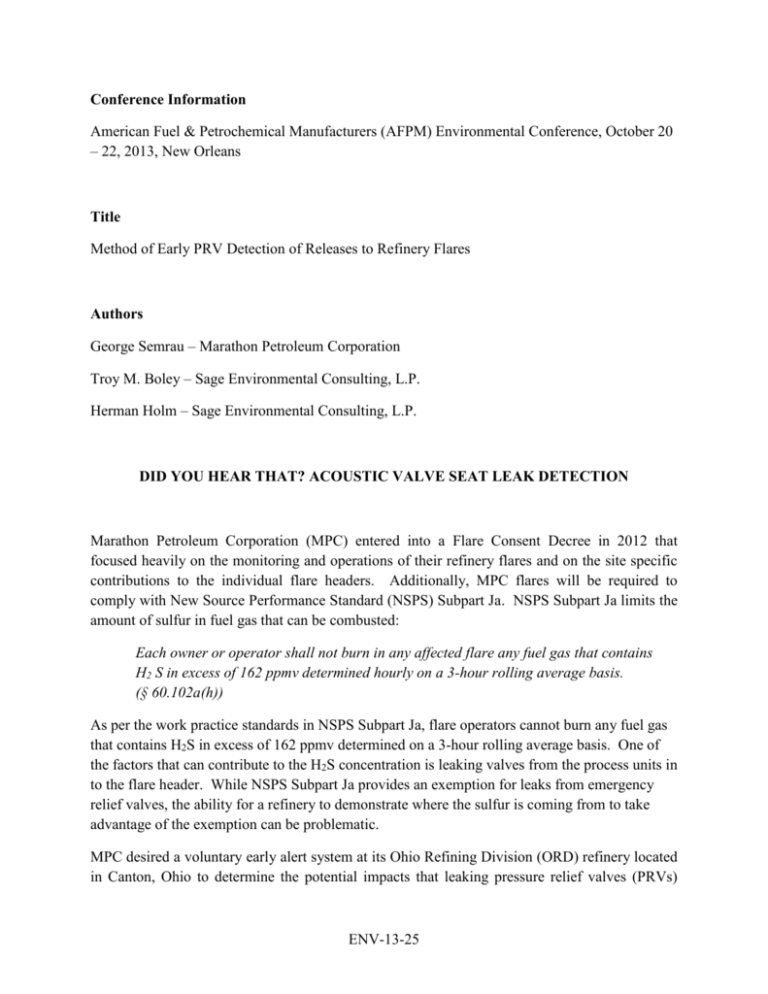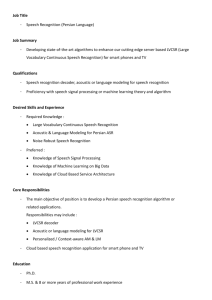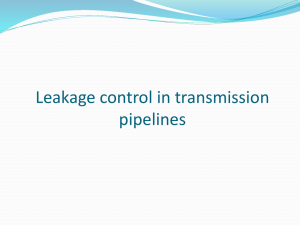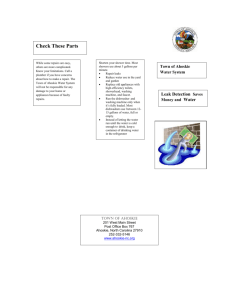White Paper - s3.amazonaws.com
advertisement

Conference Information American Fuel & Petrochemical Manufacturers (AFPM) Environmental Conference, October 20 – 22, 2013, New Orleans Title Method of Early PRV Detection of Releases to Refinery Flares Authors George Semrau – Marathon Petroleum Corporation Troy M. Boley – Sage Environmental Consulting, L.P. Herman Holm – Sage Environmental Consulting, L.P. DID YOU HEAR THAT? ACOUSTIC VALVE SEAT LEAK DETECTION Marathon Petroleum Corporation (MPC) entered into a Flare Consent Decree in 2012 that focused heavily on the monitoring and operations of their refinery flares and on the site specific contributions to the individual flare headers. Additionally, MPC flares will be required to comply with New Source Performance Standard (NSPS) Subpart Ja. NSPS Subpart Ja limits the amount of sulfur in fuel gas that can be combusted: Each owner or operator shall not burn in any affected flare any fuel gas that contains H2 S in excess of 162 ppmv determined hourly on a 3-hour rolling average basis. (§ 60.102a(h)) As per the work practice standards in NSPS Subpart Ja, flare operators cannot burn any fuel gas that contains H2S in excess of 162 ppmv determined on a 3-hour rolling average basis. One of the factors that can contribute to the H2S concentration is leaking valves from the process units in to the flare header. While NSPS Subpart Ja provides an exemption for leaks from emergency relief valves, the ability for a refinery to demonstrate where the sulfur is coming from to take advantage of the exemption can be problematic. MPC desired a voluntary early alert system at its Ohio Refining Division (ORD) refinery located in Canton, Ohio to determine the potential impacts that leaking pressure relief valves (PRVs) ENV-13-25 could have on the overall H2S concentration. MPC installed approximately 69 Emerson Model 708 Wireless Hart Acoustic Transmitter monitors on PRVs that were anticipated to contribute significantly to the H2S concentrations if they were to begin leaking. Acoustic Leak Detection: How it works! In the process of valve leakage, material loss through a small opening results in turbulent flow which produces acoustic energy. The amount of acoustic energy lost as a result of the leak can be detected using an Acoustic Emission (AE) device. AE equipment uses sensors that detect sound at a frequency range of 60 to 600 kilohertz (kHz). The noise generated from a leaking valve is carried through the fluid, valve, and pipe walls to be detected by the sensors. The amount of energy lost when compared with an experience base can also be related to the actual leakage rate. Methods of Monitoring There are two main methods of acoustically monitoring such valve seat leakages. They are mounted vs. handheld monitoring - Handheld Requires operators to physically walk to process units of concern in order to make a measurement Frequency of measurements made is restricted by the availability of personnel Cannot be a reliable method for early detection of leaks as operators cannot take reading very frequently Mounted One time installation involved at the desired location Setting the time intervals for data to be recorded allows any number of measurements to be made without the need for personnel on site Can detect leaks at an early stage since leaks will be detected as soon as they start Based on these parameters, the mounted sensors are able to provide a more robust data set that will lead to a larger amount of leaks being identified. ENV-13-25 Mounted Acoustic Monitor at MPC Canton Refinery Acoustic Detectors: Data Collection Use of AE Data – Based on testing performed in labs as well as on the field, several algorithms have been developed in order to predict leakage rates based on the AE reading. Some of the factors affecting seat leakage rates include the type of process fluid, fluid density, pressure differential, valve type, and pipe size. Pros & Cons – Things to be aware of Valve leakage information is valuable for maintenance planning to determine if the valve maintenance needs to be performed immediately or scheduled to correspond with future shutdowns. This prioritization can lead to cost savings during turnarounds. The monitors can exhibit different levels of “normal” non-zero acoustic levels due to process vibration, for example, noise attributed to nearby reciprocating compressors. MPC will be examining data from all of the monitors to determine this background noise level to determine a set point for a leak determination. The use of the mounted acoustic meters will ideally remove ENV-13-25 the variability that can be present with portable monitors that will have slight variation in measurement technique. Emerson’s AMS software provides a very simple “dashboard” user interface to monitor the data. The dashboard contains a tool to determine alert thresholds based on historical data. MPC intends to provide PI users the ability to monitor the acoustic data in PI. MPC will use some form of the thresholds generated by AMS in PI as an alert. In addition to acoustic data the transmitter, the monitors also provide pipe surface temperature which we also trend in PI. Increasing temperatures on the flare header side of a valve provides additional indication that a leak is occurring. Conclusions The Emerson Acoustic Transmitters provide a means to constantly monitor valves for early leak detection. This early detection can become critical when monitoring valves that would allow high H2S streams to enter the flare header in light of the new NSPS Ja H2S limits. MPC has installed 69 monitors in its Canton Refinery and has begun obtaining preliminary data. MPC will be working with Emerson to interpret the data to begin determining the thresholds for positive leak detection. Based on early results, MPC has potentially obtained data representing quiet PRVs with no leaks, PRVs in high vibration service with no leaks, simmering PRVs, and PRVs leaking on an intermittent basis. References 1. 40CFR § 60.102a(h) 2. Emerson Process Management, and Fisher. "A White Paper - Using Acoustic Emissions to Determine In-Service Valve Leakage." (2013): 1-3. May 2013. Web. 3. Marathon Petroleum Corporation, Ohio Refining Division, August 2013 ENV-13-25








